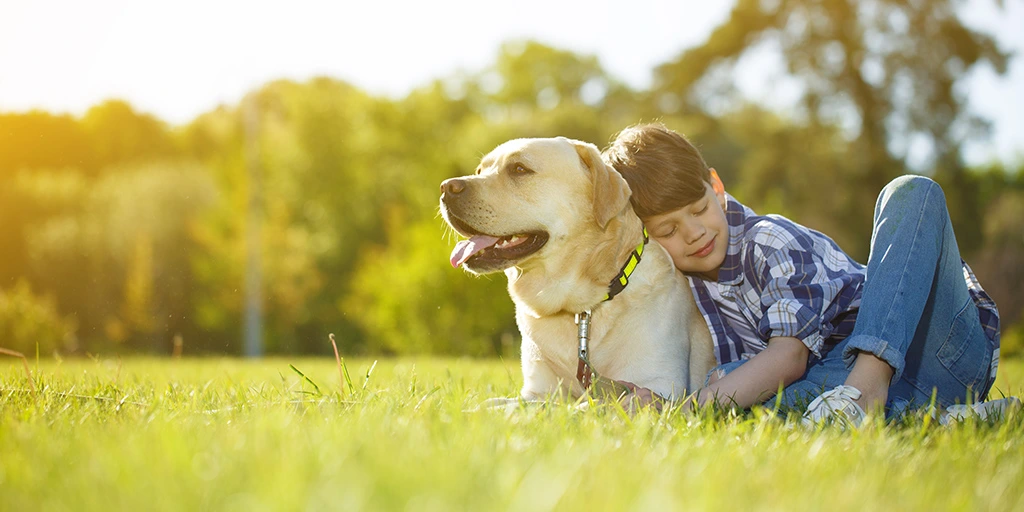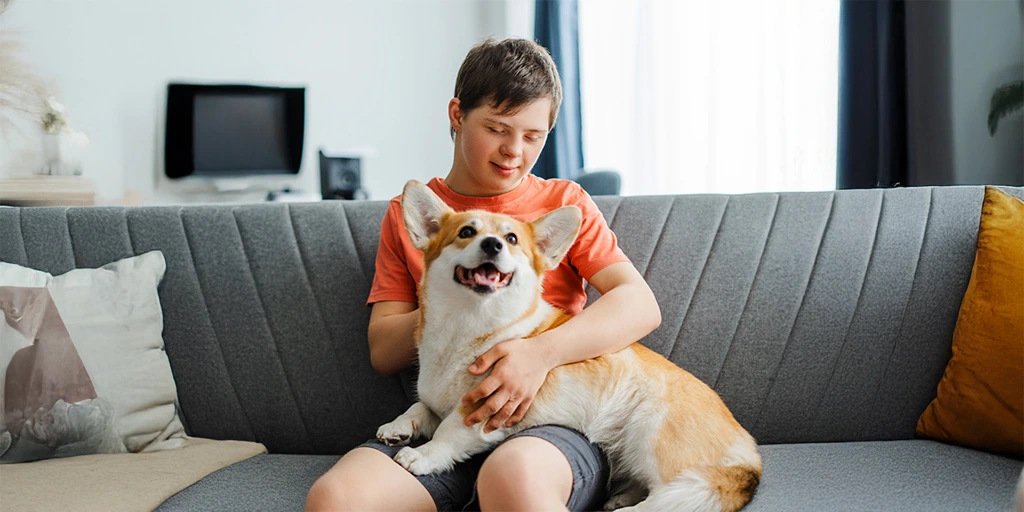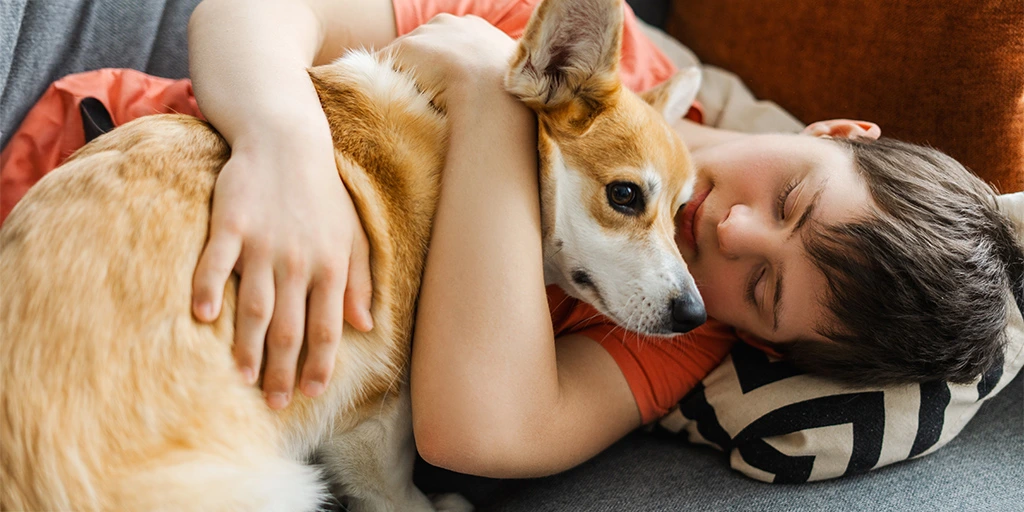A Guide to Animal Therapy for an Autistic Child
Updated on March 23, 2025Animal therapy has been proven to offer incredible benefits for children with autism and other special needs – helping with social skills, emotional regulation, and anxiety reduction. But as a parent, you may wonder: Is this the right choice for my family? What if allergies, costs, or responsibilities become an issue?
To address these concerns, let’s take a deep dive into the world of animals as caregivers. You might be convinced to think again about adding someone new and furry to your family!
Animals are such agreeable friends – they ask no questions; they pass no criticisms.
George Eliot

3 Main Types of Animal and Pet Therapy Programs
Typically, we think of pets as a sort of friend who shares our living space and is fun to be with. But they are so much more. Some animals are carefully selected for their therapeutic nature, and others are trained to an almost “professional” level. Here are the 3 main types of pet therapy:
1. Animal Assisted Therapy (AAT)
AAT programs are goal-oriented, as the animals are used to specifically facilitate healing and rehabilitation. Rather than simply placing a companion animal in the home, these programs are targeted, personalized, and separate the therapy from the actual caring of the animal (which is done by professionals). During sessions, children come to visit the animals, or in some cases, therapists will bring the animals to the child.
These animals can be used to improve social, emotional, and cognitive functioning, and may be helpful in motivating children with special needs in the course of their therapy. Animals in this category may include domesticated pets, farm animals, and marine mammals such as dolphins.
Animals are reliable, full of love, true in their affections, predictable in their actions, grateful and loyal. Difficult standards for people to live up to.
Alfred A. Montapert
2. Assistance or Service Dog
For this type of therapy, the animal – usually a dog – is placed in the home. These dogs are highly skilled and trained to perform tasks to assist a person with physical or special needs. Examples include turning on lights, picking up items, and being alert for certain sounds. For children with autism, these dogs are taught to recognize behaviors such as self-harm, disorientation, and overstimulation, and respond in specific ways to stop the cycle, alert a caregiver, or move the child to a safe space. Service dogs can also assist children with physical disabilities by performing mobility tasks, such as opening doors or retrieving objects. Some are even trained to detect seizures before they happen, offering life-saving alerts. In the US, they are included as part of ADA law.
It’s important to note that assistance animals tend to stay with a family for the long-term. By extension, the family is responsible for taking care of the dog. Owners are expected to attend a course that teaches them how the animals can do their best work.
Dogs are better than human beings because they know but do not tell.
Emily Dickinson

3. Companion Animals
These pets are placed by an organization that has evaluated the animal to make sure it has the right temperament to assist a special needs child; but otherwise, they are untrained. A companion pet can make a world of difference to a child with autism or special needs. Studies show that pets provide a sense of security, decrease anxiety, and improve motivation, to name just a few of the benefits.
In this case, the right fit of personality between child and pet is one of the most important considerations. It may even take some test runs to find an animal with the right character and behavior to match your child. Several organizations can assist with that search and the criteria behind it.
You can say any foolish thing to a dog, and the dog will give you a look that says, ‘My God, you’re right! I never would’ve thought of that!
Dave Barry
Factors to Consider When Choosing an Animal Therapy
Now that we’ve laid out the options, let’s examine some key considerations that can make your commitment to animal therapy a bit easier to manage.
Identifying Goals
What are your specific goals for your child when it comes to pet therapy? We strongly advise making a long-term plan so that you have a better idea of what therapy animal to choose. For instance, are you looking for a companion animal that can increase empathy and social interaction in a child with autism? Or is it something more specific, such as resistance to therapy or participation? Here, autistic kids can often find more motivation to participate and work harder when an animal is present.
Start with a plan drawn up with your team – doctors, social worker, therapist, and teacher – about your goals, and which type of pet therapy might benefit your child.

Be Realistic About Your Family
Before committing to animal therapy, consider the following:
- Time & responsibility: Service and companion animals require full-time care.
- Allergies & household needs: Are there sensitivities in the family?
- Therapy goals: Are you looking for emotional support or specific behavioral improvements?
- Financial considerations: Can you afford care, training, or potential veterinary expenses?
Think Outside the Box–or Cage
Got allergies? Can’t commit to caring for a hands-on pet? An alternative you might consider is a non-mammal. Did you know that watching an aquarium can have calming and stress-reducing effects on humans?
You can also contact a local aquarium to see if they have programs that invite children with special needs to visit for “up close and personal” time with the attractions. Many aquariums have regular events, are open to families after hours, and accommodate the sensory issues of children with special needs.
You can also consider therapeutic horses! It keeps your house animal-free while still offering the powerful benefits of animal therapy. Most regions have centers and organizations that provide equine therapy through trained animals and staff. If you are in the US, try PATH International to find a location near you.

Make it Less Expensive
Maybe inviting an assistance or service animal into your home is something you would love to do. You have the room, the desire, and the time. But these animals can be expensive to obtain, as their training is specific and costly. Plus, if you are making the investment, you want to make sure that the animal is going to be an asset, not a hindrance to your child!
Fortunately, there are organizations that can assist with the costs of training and acquiring a service animal. Did you also know that Medicaid may offer assistance? Check with your social worker or local Medicaid office.
Therapy for the Whole Family
Ready to go for it? We hope that, whatever option you choose, the animal will open up a new world for your special needs child. But more than that, you might just be looking at spending time with a kind creature that benefits the entire family. With a temperament that is chosen specifically for calmness and the ability to help, chances are that everybody will fall in love with your therapy animal.
AngelSense creates a safer world for children with special needs, with a wearable GPS tracking and listening device, a web app and smart analytics.
Get peace of mind from AngelSense, the groundbreaking AI-based assistive technology designed to enhance safety and peace of mind for individuals with special needs and their families. Our solution ensures you stay connected with your loved ones, empowering a higher level of independence while maintaining safety. Learn more about how AngelSense can make a difference for your family.
Get peace of mind from AngelSense, the groundbreaking AI-based assistive technology designed to enhance safety and peace of mind for individuals with special needs and their families. Our solution ensures you stay connected with your loved ones, empowering a higher level of independence while maintaining safety. Learn more about how AngelSense can make a difference for your family.

